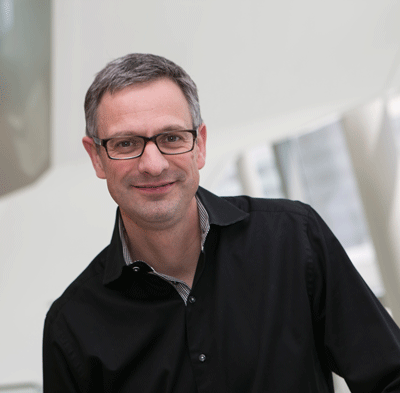 |
|
|
Job Dekker, PhD |
Scientists at UMass Medical School, Pennsylvania State University and Florida State University have developed a new computational framework combining three methods of finding large mutations in cancer cells into a single, more complete model. The new method, described in a study published in Nature Genetics, will help researchers find what are called “structural variants” within cancer genomes and learn more about how such cancers begin.
Each of the three methods alone only reveals a portion of the structural variations found in cancer cells, but when the results of all methodologies are integrated using the new model, a more comprehensive view of the genome emerges, said study authors Job Dekker, PhD, Howard Hughes Medical Institute Investigator, the Joseph J. Byrne Chair in Biomedical Research, professor of biochemistry & molecular pharmacology and co-director of the Program in Systems Biology at UMMS, and Feng Yue, PhD, assistant professor of biochemistry and molecular biology at Penn State.
Structural variants are large mutations in DNA that can activate cancer-causing genes. Knowing which mutations are present can give scientists clues about how the illness started or what treatment may be effective. For example, certain types of brain cancer can be caused by structural variants that amplify cancer-causing genes. In some cancers, knowing a patient has this abnormality helps doctors decide on a treatment plan.
The tools—optical mapping, high-throughput chromosome conformation capture (known as Hi-C) and whole genome sequencing—have been used to discover the majority of structural variants that are already known. The new approach combines them into a single framework, directing researchers to structural variations for more than 30 types of cancer cells. Scientists are also able to use the method to study why certain classes of structural variants may contribute to cancers.
“Many of the structural variants that are found in human cancers do not appear to directly impact a gene,” said Jesse Dixon, MD, PhD, a fellow at the Salk Institute in San Diego, and one of the co-authors of the work. “Instead, many structural variants appear in noncoding portions of the genome, what people have historically referred to as ‘junk DNA,’ and it can be a bit of a mystery as to why these may be contributing to cancer.”
What the researchers were able to observe is that some structural variants appear to affect regulatory gene switches in noncoding sequences of DNA. Defective switches prevent appropriate turning on or off of specific genes.
“With many cancers, the gene itself is OK but the switch that controls it causes problems,” Dr. Yue said. “Using our approach, it’s possible that we could find out that the switch was broken and find a cure based on the specific target for that switch.”
They also used the Hi-C method to explore how structural variations can affect 3D genome structure—that is, how DNA folds itself within the cell.
“Cells are small, but their DNA is very long. Laid out in a line, all the DNA from one cell would be more than two meters long,” said Dr. Dekker. “That’s why DNA needs to fold in intricate ways. We have found that genomic alterations in cancer cells can lead to differences in how the genome folds and this can lead to cases where genes become turned on or off by the wrong regulatory switches.”
This study showed that structural variants impact genome folding in cancer cells, and that these changes may be contributing to cancer.
“One of discoveries we had made in the past is that our genome is folded up into distinct structures, almost like little neighborhoods,” Dixon said. “It appears as though some structural variants cause changes to these neighborhoods, such that a cancer-causing gene is moved from a neighborhood where the gene is kept quiet into one where the gene becomes activated.”